

4 Mistakes Inexperienced Builders Make When Working with Concrete and Concrete Forming Systems. Interesting Facts about Concrete Forming Systems that Every Builder Should Know. Factors to Consider When Designing Concrete Forming Systems. Factors to Consider When Choosing among Popular Types of Concrete Forming Systems. Rookie Mistakes to Avoid When Working with Concrete Forming Systems. Concrete Forming Systems and Other Factors that Influence the Outcome of Construction. Avoiding Resurfacing with Aluminum Concrete Forming Systems. Concrete Forming Systems and Other Elements of a Successful Concrete High-Rise Construction.
What Are the Functions of Concrete Forming Systems? Effects of Disproportion in Concrete Mixture and the Importance of Concrete Forming Systems. Wednesday, May 1, 2019 Effects of Disproportion in Concrete Mixture and the Importance of Concrete Forming Systems To produce high-quality concrete, use the right proportions of cement, aggregate, and water.
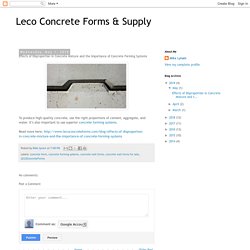
It’s also important to use superior concrete forming systems. Read more here: Posted by Mike Lynam at 7:08 PM Email ThisBlogThis! Basic Facts about Concrete Forming Systems Every Construction Professional Should Know. Using Concrete Forming Systems and Other Ways to Produce Hard-Wearing Concrete - LECO Concrete Forms. Reinforced concrete is arguably the most hard-wearing construction material ever discovered.
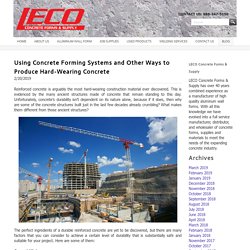
This is evidenced by the many ancient structures made of concrete that remain standing to this day. Unfortunately, concrete’s durability isn’t dependent on its nature alone, because if it does, then why are some of the concrete structures built just in the last few decades already crumbling? What makes them different from those ancient structures? The perfect ingredients of a durable reinforced concrete are yet to be discovered, but there are many factors that you can consider to achieve a certain level of durability that is substantially safe and suitable for your project.
Here are some of them:Correct MixtureIt has been known for a long time that for concrete to be strong, it must contain five different ingredients—cement, fine aggregate, coarse aggregate, water, and admixture. The Role of Concrete Forming Systems in Construction. Concrete Forming Systems and Other Factors that May Influence the Concrete Pouring Process. The Amazing Benefits of Using Aluminum Concrete Forming Systems.
Forming systems have been used for construction since time immemorial.
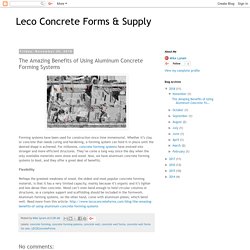
Whether it’s clay or concrete that needs curing and hardening, a forming system can hold it in place until the desired shape is achieved. For millennia, concrete forming systems have evolved into stronger and more efficient structures. They’ve come a long way since the day when the only available materials were stone and wood. What You Need to Know about Building Walls and Concrete Forming Systems. Any habitable structure consists of at least five major elements—foundation, floor, wall, columns, and beams.
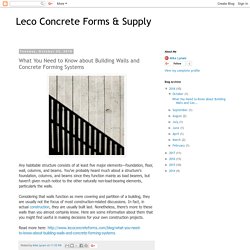
You’ve probably heard much about a structure’s foundation, columns, and beams since they function mainly as load bearers, but haven’t given much notice to the other naturally non-load-bearing elements, particularly the walls. Considering that walls function as mere covering and partition of a building, they are usually not the focus of most construction-related discussions. In fact, in actual {*style:<a href=' they are usually built last. Nonetheless, there’s more to these walls than you almost certainly know. What You Need to Know about Concrete before Using Concrete Forming Systems in Your Project. Concrete Forming Systems: How Do You Know If You Are Using the Right Material? Thirteen construction workers were severely injured while working at a mixed-use development in Oakland, California on May 2017.
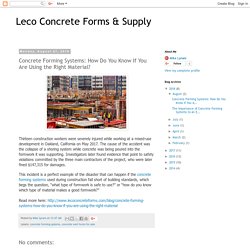
The cause of the accident was the collapse of a shoring system while concrete was being poured into the formwork it was supporting. Investigators later found evidence that point to safety violations committed by the three main contractors of the project, who were later fined $147,315 for damages. The Importance of Concrete Forming Systems to an Efficient Job Site. The Benefits of Using Modern Concrete Forming Systems for Your Structures. The concrete forms used by builders in the United States have come a long way from traditional plywood to metal or combination.
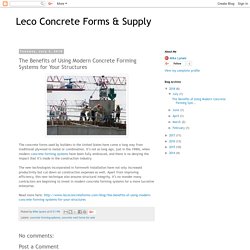
It’s not so long ago, just in the 1990s, when modern concrete forming systems have been fully embraced, and there is no denying the impact that it’s made in the construction industry. The new technologies incorporated in formwork installation have not only increased productivity but cut down on construction expenses as well.
Apart from improving efficiency, this new technique also ensures structural integrity. Concrete Placement and Curing in Quality Concrete Forming Systems. How Much Do You Know about Concrete Forming Systems? Concrete is a tough material to work with, but with the right mixture and curing it can provide the support and protection your structure needs.
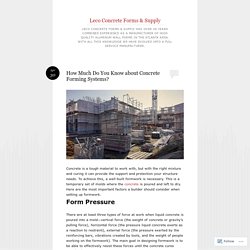
To achieve this, a well-built formwork is necessary. This is a temporary set of molds where the concrete is poured and left to dry. Here are the most important factors a builder should consider when setting up formwork. How Concrete Forming Systems Work and the Best Reasons to Use Them. Every well-built structure made of concrete started out as bare skeletons of reinforcing bars and scaffolds.
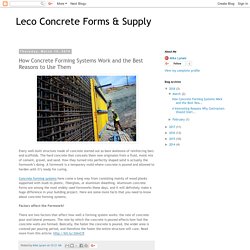
The hard concrete that conceals them now originates from a fluid, moist mix of cement, gravel, and sand. How they turned into perfectly shaped solid is actually the formwork’s doing. 4 Interesting Reasons Why Contractors Should Start Using Aluminum Concrete Forming Systems. Tips on Finding Quality Concrete Forming Systems for Construction Work. {*style:<a href=' forming systems{*style:</a>*} are high in demand in construction work precisely because it is more efficient to use than the traditional lumber and plywood forms.
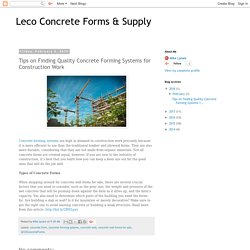
They are also more durable, considering that they are not made from organic materials. Not all concrete forms are created equal, however. If you are new to the industry of construction, it’s best that you learn how you can keep a keen eye out for the good ones that will do the job well. Types of Concrete Forms When shopping around for concrete wall forms for sale, there are several crucial factors that you need to consider, such as the pour size, the weight and pressure of the wet concrete that will be pushing down against the form as it dries up, and the form’s capacity.
You also need to determine which parts of the building you need the forms for. The Role of Concrete Forming Systems in Dealing with Concrete Cons. Concrete is considered as an irreplaceable construction material.
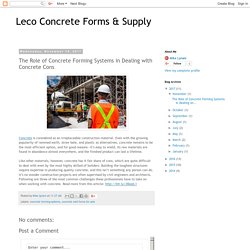
Even with the growing popularity of rammed earth, straw bale, and plastic as alternatives, concrete remains to be the most efficient option, and for good reasons—it’s easy to wield, its raw materials are found in abundance almost everywhere, and the finished product can last a lifetime. Like other materials, however, concrete has it fair share of cons, which are quite difficult to deal with even by the most highly skilled of builders. Building the toughest structures require expertise in producing quality concrete, and this isn’t something any person can do. Concrete Forming Systems: Why Choose Aluminum Over Traditional Lumber? These days, concrete forming systems are utilized in almost all types of building project. Because these systems are made up of lightweight aluminum panels that are easy to assemble and dismantle, the entire concrete forming process becomes a whole lot easier; even unskilled workers can perform them.
Of course, it pays to know a few tips on speeding up concrete curing periods to maximize the gains that you can get out of using concrete forms. Concrete Forming Systems: Why Choose Aluminum Over Traditional Lumber? Keeping a building project on track—or even better, finishing it early—equates to huge savings for builders. However, quality should never be sacrificed for speed, that’s why builders need to ensure the job is done right while maximizing time. Concrete forming systems help them achieve both.
Aluminum concrete forms in particular, not only offer significant time and labor savings, but costs as well, when compared to conventional framing materials such as lumber. Top quality aluminum concrete forms for sale, such as those sold by LECO Concrete Forms & Supply, provide customers with an efficient, time-saving, and labor-saving, and money-saving product that gives great long-term value. Aluminum forming panels are manufactured in factories that implement highly controlled processes, and so the quality and consistency of each panel is ensured. Here's How You Can Utilize Concrete Forming Systems in Your Structure.
When you need to build a structure that could withstand the elements, you need to choose your materials carefully. It has to be durable as well as incredibly easy and effective to work with so it does not negatively affect build efficiency. Hence, you should definitely consider using concrete forming systems to get the job done. A concrete forming system allows for concrete to be formed in such a way that it would fit a particular architectural design without compromising stability. These forms are usually made of aluminum which makes them not only very light but sturdy as well. They also require only a hammer and a couple of wrenches to use. Why Choose Aluminum over Other Materials for Concrete Forming Systems. Form systems play a major role in construction projects that involve the use of concrete. They are responsible for ensuring that concrete is shaped according to the required architectural design without compromising stability.
With building designs becoming more and more complex as demands for functional space continues to grow, developing concrete forming systems is also becoming increasingly challenging. The most common types of concrete form material are plywood and steel. While both exhibit beneficial qualities, they may not be ideal for certain types of project. For instance, plywood-based formwork may not be ideal for high-rises since constructing tall buildings involves a much heavier load, which the form may not be able to hold. Tips on Safety and Productivity When Using Concrete Forming Systems. How to Maintain Your Concrete Forming Systems for Longer Term Use.
Concrete Forming Systems Open up Possibilities in the Building Sector. Why You Should Use Concrete Forming Systems for Outdoor Structures. Top Things You Should Consider in Choosing Concrete Forming Systems. In construction, formwork is the basic mold or skeleton that holds together the shape of a structure. Yet the formwork wouldn’t be as effective in fulfilling this task without a structurally sound design.
With an impregnable design, any structure can withstand all types of load and remain rigid without the risk of any changes in its original shape. Quality Concrete Forming Systems Make the American Dream Into Reality. When to Use Aluminum Concrete Forming Systems in Your Project and Why. Reasons to Use Concrete Forming Systems in Your Construction Projects. Build Excellent American Dream Homes with Concrete Forming Systems. Why Use Aluminum Concrete Forming Systems in Your Construction Project.
How Quality Concrete Forming Systems Ensure the Quality of Your Build: lecoconcretega. How Concrete Forming Systems Make Construction Kinder to the Planet: lecoconcretega. ( ) - It’s official: green is in. According to research conducted by Nielsen, about 55% of respondents said they are willing to pay extra for eco-friendly products; about half of them have gone on to purchase such products in the past six months. Is it any wonder, then, why construction companies have also gone green? The future is looking even greener for homebuilders willing to go the extra mile to lessen a construction project’s environmental impact.
The U.S. Green Building Council estimates that industry revenue should hit $245 billion by 2016. That said, making your projects “greener” doesn’t require too huge an investment. Abundant and Recyclable. Take Advantage of Housing Boom with Quality Concrete Forming Systems. How Concrete Forming Systems Make House Construction a Lot Easier. Concrete Forming Systems: Four Reasons They are Highly Recommended. Concrete may have been associated with buildings and prisons in the past, but it is now gaining popularity among people who want to build their own homes. Understanding Aluminum Concrete Forming Systems and Their Benefits. The Benefits of Using Aluminum Concrete Forms in Construction Projects. Concrete Forming Systems a Vital Part of Home and Other Constructions. Concrete Forming Systems: Making a Case for Sturdy Home Foundations.
Concrete Forming Systems Are Essential as Concrete Homes Come of Age. Quick Form: Contractors Build Faster with Concrete Forming Systems. A Primer on the Different Concrete Forming Systems for Construction. Concrete has long been the material of choice for many construction projects, more particularly for building homes. Concrete, however, can be difficult to move around and placed on a particular part of the house, for a square foot of conventional concrete typically weighs around 150 pounds.
Imagine how difficult it will be to place hundreds to thousands of square feet of concrete at the same time. Concrete Forming Systems Wholesaler Now Supplying Mar-Flex Products. Good Concrete Forming Systems to Match Your House Decoration Ideas. Top-of-the-line Concrete Forming Systems Can Help Create Dream Homes. Premium Concrete Forming Systems Equipment Now Available Through Loan. Concrete Forming Systems Help Mitigate Damage in Flood-Prone Areas. Cut Down on Costs and Gear up on Reliable Concrete Forming Systems. Quality Concrete Forming Systems Make Magnificent Structures Possible.
Construction Basics: Significance of Quality Concrete Forming Systems.